|
|
|
Sort Order |
|
|
|
Items / Page
|
|
|
|
|
|
|
| Srl | Item |
| 1 |
ID:
190877
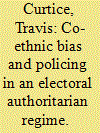

|
|
|
|
|
| Summary/Abstract |
Why do people cooperate with police in multi-ethnic societies? For scholars of comparative politics and international relations, examining the effects of ethnicity on patterns of conflict, cooperation, and state repression remains a foundational endeavor. Studies show individuals who share ethnicity are more likely to cooperate to provide public goods. Yet we do not know whether co-ethnic cooperation extends to the provision of law and order and, if so, why people might cooperate more with co-ethnic police officers. In the context of policing, I theorize co-ethnic bias affects interactions between people and the police because individuals prefer officers who share their ethnicity and fear repression more when encountering non-co-ethnic officers. Using a conjoint experiment in Uganda, I demonstrate that individuals prefer reporting crimes to co-ethnic officers, even after controlling for potential confounders. Broadly, this result is strongest among individuals with no trust in the police, the courts, or the political authorities. These findings have important implications for the politics of policing, conflict, and social order.
|
|
|
|
|
|
|
|
|
|
|
|
|
|
|
|
| 2 |
ID:
190888
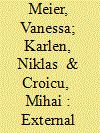

|
|
|
|
|
| Summary/Abstract |
In this article, we present the most up-to-date, fine-grained, global dataset on external support in armed conflicts: the UCDP External Support Dataset (ESD). The dataset encompasses data on states and non-state actors as both supporters and recipients and provides detailed information on the type of support provided to warring parties in armed conflicts between 1975 and 2017. We use it to highlight three broader trends in the provision of external support: (1) a dramatic increase in the number of external supporters, (2) a larger share of pro-government interventions, and (3) the rise of direct military intervention as the predominant mode of external support. In conclusion, we identify several avenues worthy of future inquiry that could significantly improve our understanding of external support in armed conflicts.
|
|
|
|
|
|
|
|
|
|
|
|
|
|
|
|
| 3 |
ID:
190885


|
|
|
|
|
| Summary/Abstract |
What prolonged implications does conflict escalation have on voting behavior? The literature focuses primarily on the immediate effect of violent events on voting in nearby elections, leaving open questions about longer-term consequences. This article examines this question by studying Israel, where violent escalation in the Israeli–Palestinian conflict in the early 2000s was followed by an unexpected electoral outcome: the emergence and consolidation of a new centrist bloc that transformed a longstanding Left-Right partisan divide into a three-bloc system. Using two decades of survey data, it is argued that this shift is best explained by a long-term attitudinal change toward the conflict by many Israelis after the escalation. Rather than a strictly hawkish shift, many voters have become ‘Doubtful Doves’: supportive of territorial compromise in principle, but skeptical about reaching an agreement with the Palestinians in practice. This underdiscussed attitudinal structure, dovish but doubtful, has formed a new electoral base for centrist parties, breaking the traditional Left-Right dichotomy. These findings illustrate that violent periods in conflicts can cause non-trivial long-term changes in popular attitude structures and voting patterns, which, under the right conditions, can trigger electoral re-equilibration.
|
|
|
|
|
|
|
|
|
|
|
|
|
|
|
|
| 4 |
ID:
190884


|
|
|
|
|
| Summary/Abstract |
This article investigates how and when regime transitions intensify minority discrimination through an analysis of two types of religious persecution following the Arab uprisings. We argue that weakened institutions and the prevalence of religious outbidding during political transitions make societal-based religious discrimination (SRD) more likely to increase than government-based religious discrimination (GRD). This is because social divisions are often exacerbated and social unrest difficult to contain, while at the same time, policy change can be difficult to enact and enforce. We test these claims through a mixed-methods research design. Employing a synthetic control method, the cross-national, quantitative analysis from 1990 to 2014 confirms that GRD has not changed since the Arab uprisings, while SRD has substantially increased in those countries (i.e. Egypt, Libya, and Tunisia) that also experienced regime change. A case study of Egypt provides more direct evidence of the institutional and outbidding mechanisms. The qualitative analysis draws on ethnographic research conducted in Cairo during 2014, which includes in-depth interviews with Coptic Orthodox Christians. Our findings underscore the twin challenge of protecting and accommodating minority religions during periods of political transition.
|
|
|
|
|
|
|
|
|
|
|
|
|
|
|
|
| 5 |
ID:
190881


|
|
|
|
|
| Summary/Abstract |
It is common during a civil war that a government’s counterinsurgency operations result in internally displaced persons seeking refuge from the violence by leaving their communities. However, many civilians alternatively choose to stay in their homes and seek accommodation from the rebels. It is, therefore, puzzling that in a civil war situation when rebel cadres often cannot protect civilians, civilians would remain in their communities. This article argues that the wartime provision of public services motivates civilians to stay with the rebel group because it demonstrates the group’s capability for and commitment to developing civilians’ welfare and livelihoods. This argument offers insight into an unanswered question in the literature regarding internal displacement in a civil war: Why do some civilians, when facing protection issues in rebel-held areas, choose to stay, while others opt to leave? Using novel survey data collected over two phases from the former Federally Administered Tribal Area (FATA) in Pakistan, a two-step Bayesian propensity score analysis reveals that the civilians who received rebel services are less likely to leave their places of residence. Civilians would pursue long-term goals during the crossfire between the government and rebel forces; wartime provisions of public services allow civilians to seriously consider the possibility of improving their lives.
|
|
|
|
|
|
|
|
|
|
|
|
|
|
|
|
| 6 |
ID:
190880


|
|
|
|
|
| Summary/Abstract |
Extant research highlights low or unequal access of ethnic groups to socio-economic resources as a driver of communal violence. However, less is known about how institutional factors, such as control over ethnofederal units, influence the distribution of these resources in the first place. Conversely, the literature on ethnofederalism has focused on conflicts that involve the central government, while neglecting its unintended consequences at the subnational level. Building on both literatures, we argue that ethnofederalism increases the risk of communal violence between locally dominant and non-dominant groups through two mechanisms. First, it increases grievances among locally non-dominant groups. Second, it increases the utility of coercive strategies for locally dominant groups. Through both processes, ethnofederalism creates incentives for group elites to use communal violence in order to attain or maintain control over local government office. We test our argument in a subnational analysis of Ethiopia’s ethnofederal system, combining new spatial data on local demographics, government control, and horizontal inequalities. We further substantiate our analysis with quantitative tests of the mechanisms’ intermediate implications and with original interview data gathered during fieldwork. Our results highlight the importance of accounting for institutional factors in the comparative study of communal violence.
|
|
|
|
|
|
|
|
|
|
|
|
|
|
|
|
| 7 |
ID:
190882
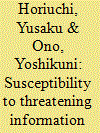

|
|
|
|
|
| Summary/Abstract |
A growing number of news articles and politicians’ statements treat refugees as potential terrorists. However, existing research has yet to thoroughly examine how threatening information about refugees affects natives’ attitudes toward refugee resettlement. To address this issue, we conducted a survey experiment in Japan, where the number of refugees accepted each year is extremely small, despite the rapid increase in news about refugees. Our results show that opposition to refugee resettlement is associated with its proximity. Specifically, we find two types of NIMBY (not-in-my-backyard) attitudes – within-country and between-country NIMBY-ism – toward refugee resettlement among Japanese people. Additionally, respondents become more strongly opposed to refugee resettlement when exposed to threatening frames that depict refugees as harmful, regardless of the proximity to threats and potential resettlement. These findings add nuance to the scholarly literature on threat perceptions and public attitudes in intergroup relations. First, our findings suggest that NIMBY attitudes toward refugee resettlement (shown in Ferwerda, Flynn & Horiuchi, 2017) are not a US-only phenomenon. Second, we provide empirical evidence to support the theory that subjectively perceived threats affect people’s hostility toward out-group members, even in the absence of actual threats. Finally, we contribute to the recent debate on the effects of proximity to threats. Our results support the argument that the psychological effects of terrorism on negative attitudes toward immigrants and refugees are more pronounced in homogeneous societies, irrespective of proximity to the threat.
|
|
|
|
|
|
|
|
|
|
|
|
|
|
|
|
| 8 |
ID:
190886
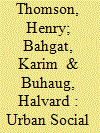

|
|
|
|
|
| Summary/Abstract |
The world’s population is increasingly concentrated in cities. Research on urbanization’s implications for peace and security has been hampered by a lack of comparable data on political mobilization and violence at the city level across space and through time, however. Urban Social Disorder 3.0 is a detailed event dataset covering 186 national capitals and major urban centers from 1960 to 2014. It includes 12 types of nonviolent and violent events, detailing the actors involved and their targets, start and end dates of each event, and the number of participants and deaths. We provide an overview of the main features of these data, and trends in urban social disorder across space and time. We demonstrate the utility of the dataset by analyzing the relationship between city size and the frequency of lethal disorder events. We find a positive relationship between city population and lethal urban social disorder, unlike previous studies. These new data raise promising avenues for future research on democratization; climate change and food security; and spillovers between different forms of mobilization and violence.
|
|
|
|
|
|
|
|
|
|
|
|
|
|
|
|
| 9 |
ID:
190883
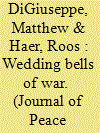

|
|
|
|
|
| Summary/Abstract |
Child marriage is a fundamental violation of human rights. It hinders progress towards development and public health goals. In this study, we argue that armed conflict plays an important role in the occurrence of child marriages; it influences the supply of and demand for young brides. We argue that in conflict settings, families are more willing to marry off their young daughters for protection. Armed conflict can also influence the demand: marriage in general declines due to an imbalance in sex ratio. However, in cases where belligerents use war tactics specifically focused on harming girls, such as sexual violence and girl recruitment, early marriage might increase as the result of armed conflict. To empirically examine these linkages, we combine the Demographic and Health Surveys of West Africa with information on the location of armed conflict. Our study shows that armed conflict generally reduces the occurrence of child marriage with 13% to 18%. However, we observe that when conflict actors use war tactics that specifically harm young girls there is a significant increase of 12% to 18% in the probability of a girl getting married before the age of 18. This research has important implications for our understanding of the relationship between armed conflict, gender inequality, and their impact on children.
|
|
|
|
|
|
|
|
|
|
|
|
|
|
|
|
| 10 |
ID:
190878
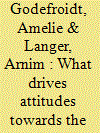

|
|
|
|
|
| Summary/Abstract |
Reintegrating ex-combatants back into society is one of the most challenging, yet fundamental components to building sustainable peace. While previous work has extensively evaluated the reintegration trajectories of ex-combatants, there is still little understanding of how citizens think about reintegration. In this article, we systematically analyze which former fighters people prefer to reintegrate into society. Based on theories of threat and justice, we develop a heuristic framework that explains how information about the motivations and behavior of ex-combatants shapes public preferences about whom to reintegrate. We test this framework using a conjoint experiment conducted among approximately 2,000 (former) university students in Nigeria. We find that our respondents are more forgiving towards former fighters who were forced to join the insurgency and expressed remorse afterwards, while being less willing to reintegrate more militant and less repentant offenders. Similar informational cues shape respondents’ evaluations of how successful the reintegration process would be and what punishment would be appropriate. Taken together, the results underscore the importance of perceptions of risk and fairness in driving attitudes towards reintegration. Finally, subgroup analyses revealed that these heuristics are broadly held across different demographic and conflict-related fault lines. While caution is warranted when generalizing these results, insights gained in this specific context are nonetheless an important step towards advancing our understanding of reintegration processes in conflict-affected countries.
|
|
|
|
|
|
|
|
|
|
|
|
|
|
|
|
| 11 |
ID:
190887
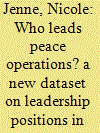

|
|
|
|
|
| Summary/Abstract |
It is widely recognized that UN peace operations have been critically influenced by their leadership personnel in the field since the first UN peacekeepers were deployed in 1948. But who exactly are the people that lead peace operations and decide how these are implemented on the ground? This special data feature introduces a new dataset on leadership positions in UN peace operations from its interception in 1948 up to 2019. The relevance of different authorities in peace operations is discussed, followed by an examination of general trends in the data with regards to the duration of term in different leadership positions, the national and regional origin of peace operations authorities, and the distribution of gender. It is shown that scholars studying a variety of topics, including policymaking at the UN, the use of force in peace operations, international responsibilities, and the role of the global south in international politics, can benefit from paying closer attention to the question of who occupies leadership positions in UN peace operations.
|
|
|
|
|
|
|
|
|
|
|
|
|
|
|
|
|
|
|
|
|